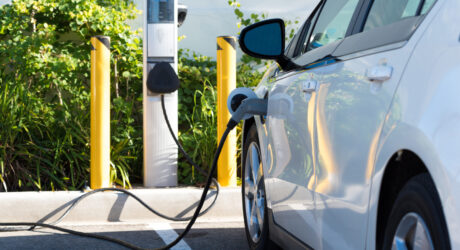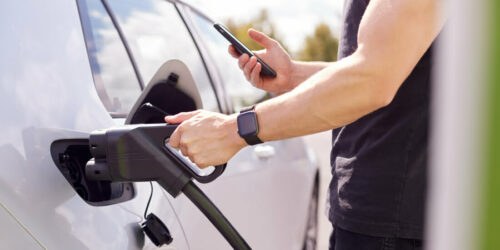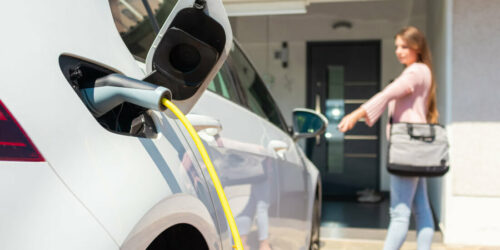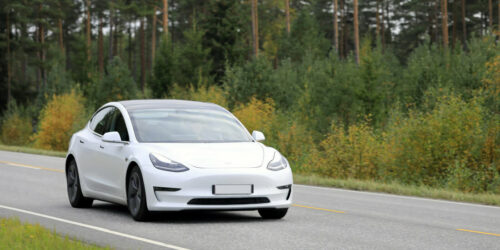A Complete Guide to Electric Vehicle Charging
- Apply for the Electric Vehicle Homecharge Scheme to save £350 on your home charging station
- There are currently 53,029 public electric vehicle charging points in the UK (44,664 more than petrol stations)
- Many modern electric vehicles can go over 200+ miles on full charge
If you’re looking for a sustainable way to make a difference and positively affect the environment, then investing in an electric vehicle is a great place to start. They’re robust and considerably cheaper to run than petrol cars. Plus, EV technology is always evolving to ensure you can go further for less. In fact, using electric vehicle charging points at home works out more economical.
But before you invest, you want to make sure you’re well informed, which is why we’ve created a complete guide to electric vehicle charging. Here you will find out the various EV charging speeds, plug variations and costs, along with a few key tips.
You will also learn more about the government’s Electric Vehicle Homecharge Scheme, where you can get £350 off the cost of a home electric vehicle charging point.

What's On This Page?
Click the links below and head straight to a specific section of the article.
- How Does Electric Vehicle Charging Work?
- What is AC and DC On Electric Vehicle Charging?
- On-Board Charging (OBC)
- EV Charging Speeds
- The Different Plug Types For Electric Vehicle Charging
- Home Charging
- Charging at Public Stations
- Charging At Work
- The Cost Of Electric Vehicle Charging
- Key Tips For EV Charging
- Is There An Electric Vehicle Charging Logo?
- Summary
How Does Electric Vehicle Charging Work?
Similar to any vehicle, an electric car will need refuelling. Only the difference is that instead of filling up your car with petrol or diesel, you will need to connect your car to a power source and let it charge. There are many ways to make use of electric vehicle charging, depending on where you are.
Each model requires a different kind of cable in order for it to connect.
There will be a connection port on your car and another one on the charging station. The cable will need to connect to both of them before electric vehicle charging can commence.
What is AC and DC On Electric Vehicle Charging?
When charging an electric car, there is the alternating current (AC) taken from the grid, which is turned into direct current (DC), which your car can then use.
DC electric vehicle charging will perform the conversion, but if you decide on an AC charger, the conversion from AC into DC will be much slower.
This is the main difference between AC chargers (known as slow and fast) and the faster DC chargers, which are called rapid and ultra-rapid.
AC chargers max out at 22kW, while making use of DC electric vehicle charging can reach 100kW or above.
Although DC chargers are more expensive, they may suit your needs better than the AC connectors.
On-Board Charging (OBC)
An electric car will have an on-board charging (OBC) system to convert AC from the charging station into DC. It’s a necessary requirement on your car as electric cars are powered by DC. Without this conversion system, after charging your electric vehicle, it wouldn't be able to run.
EV Charging Speeds
When it comes to electric vehicle connectors, there are four speeds to look out for: slow, fast, rapid, and ultra-rapid.
These will determine how quickly you can charge your electric vehicle. How long does it take to charge an electric car?
Home chargers can often be classed as slow or fast, while the majority of public charging points are fast – though some can be rapid or ultra-rapid.
Even though the idea of quickly charging your electric vehicle may sound ideal, it’s best to consider what the most cost-effective option would be.
Slow Charging
Slow charging stations are widely considered to be between 3kW and 7kW, and can be found at homes or places of work.
The stations use Type 1 or Type 2 connectors, which deliver alternating current (AC) from the grid to your car, which will then convert into direct current (DC).
Although it is possible to plug your electric vehicle into a three-pin socket, it’ll be a lot slower, charging at just 2.3kW.
It’s better to invest in a dedicated home station that is both reliable and affordable, and can recharge your car overnight. The home station is designed to transmit the required level of electricity consistently for hours at a time, giving you reliable electric vehicle charging.
Fast Charging
These stations range from 7kW to 22kW, and can be found everywhere. Most are 7kW, which is more than enough for overnight charging.
There are stations that offer 22kW, but these tend to be reserved for large businesses.
Rapid Chargers
Rapid chargers is where you will find high-speed DC chargers, ranging at 50kW to 100kW.
The stations are usually only located in public places; however, the cost is considerably higher than you would pay for domestic electricity.
No need to worry about buying a cable to connect to the car as DC charging stations come with cables that can fit securely into your car’s connector.
Ultra-Rapid Chargers
Ultra-rapid stations are superfast and will have your car ready to go in minutes, whizzing by at 100kW or more.
According to charging company Pod Point, it will only take Peugeot e-208 20 minutes to go from 20% to 80% using rapid electric vehicle charging.
The downside being that these stations can be extremely expensive when compared to home charging stations.
The Different Plug Types For Electric Vehicle Charging
There are several different types of electric vehicle charger. The one best suited to you will depend on your vehicle and how much time you spend on the road.
Domestic Three-Pin Plug
This is the traditional three-pin plug you use to power the majority of your electrical items, such as your TV, laptop, etc. You can technically use these plugs to power up your car but it’s not very efficient.
Powering at just 2.3kW, which is below a typical slow charge, makes electric vehicle charging very slow and not very practical.
Plus they were never built for powering a vehicle, which means they can be unreliable so if possible, we advise not to use them.
Type 1 and Type 2 (Slow and Fast)
Type 1 and 2 plugs are what’s used to charge cars at fast or slow speeds.
A Type 1 plug can reach a maximum of around 7kW, while Type 2 chargers can reach up to 22kW. Bear in mind that your car will have to be capable of receiving a faster charge to be able to use these fast electric vehicle charging points.
Type 2 plugs are currently the most popular in the range and come with most electric cars. However, this could all change at any moment due to the rapid speed of technology.
CHAdeMO and CCS (Rapid and Ultra-Rapid)
With rapid or ultra-rapid electric vehicle charging, your EV will have either a CHAdeMO or CCS connector. These plugs can charge your car at breakneck speeds of up to 50kW, 100kW or higher.
It’s worth noting that the Tesla Supercharger requires a Type 2 connector.
Home Charging
In order to charge your car safely and securely at home, it’s advisable to invest in a home charging station. See our top ten EV chargers for your home.
You can even get them at a lower price by using the government’s Electric Vehicle Homecharge Scheme. The initiative is there to help you potentially save 75% off the cost of buying and installing a home charger, up to £350.
Once electric vehicle charging been installed at home, all you’ll need to do is plug one end into the unit, and the other end into your car. Then it’s just a case of plugging it in when you need to charge.
You may want to leave it charging overnight, or maybe once a week, depending how often you drive, and which car you own.
Charging at Public Stations
According to Zap-Map, there are currently 57,290 public electric vehicle charging points in the UK. That’s 48,925 more than petrol stations operating across the UK in 2022, according to Statista.
A small percentage of these charging stations are free, but the majority require you to pay a considerable amount, and much more than you would pay at home. And that doesn't take into account a subscription fee.
If you need to use public electric vehicle charging, the process is relatively simple. You’ll just need to check your car’s connection type, and then find a nearby charging station.
You can do this by entering your connection type and the charge speed you require and you can access all the charging spots nearby.
A good tip is to see if there are any free stations, as it might be worth driving that little bit further out to save money.
We've put together a list of the best apps to find UK charging stations.
Charging At Work
Hopefully, electric vehicle charging stations are something that your company provides.
If so, then all that’s required is to park next to one of the stations, plug your cable into the correct outlet, and carry on your working day knowing your car is being charged. Most companies offer electric vehicle charging for free, but some still charge.
However, if your company hasn’t installed any stations, then it’s worth pointing out the Workplace Charging Scheme.
As long as your company qualifies, the scheme will cover 75% of the station costs, up to £350, for as many as 40 units across multiple sites.
That’s potentially saving £14,000, which is a sizable amount not to be dismissed. Plus, you may even get to charge your car for free.
The Cost Of Electric Vehicle Charging
At Home
Charging your electric vehicle at home is the most cost-effective choice, even with the constantly shifting price cap.
The average domestic electricity tariff is currently 24p/kWh.
EV Database shows that the average electric vehicle has a maximum charge level of 69.6kWh, so at 24p/kWh, the cost is £16.70 for a full charge.
Public Stations
Using public electric vehicle charging is always likely to be more expensive than home charging, but it’s usually quicker. At Pod Point’s Lidl rapid charging stations, it costs 65p/kWh, which means that a full charge is over double the cost of home charging. However, the benefit is that it would charge a car like the Peugeot e-208 from 20% to 80% in just 20 minutes.
Prices can sometimes fluctuate, so if you find charging stations that are less than the cost of domestic electricity, you should take advantage.
Otherwise, public charging should be used only when absolutely necessary as it can be quite costly.
The cost to charge your electric car will usually be less than petrol, but the most benefit is found by charging at home.
Key Tips For EV Charging
The cheapest way to charge your EV is by home charging
Avoid using a three-pin plug if possible. They’re slow and can often be unreliable
The charging speeds are: Slow, Fast, Rapid and Ultra-Rapid
There is AC (slow and fast) and DC (rapid and ultra-rapid) chargers
DC charging stations supply cables but AC stations don’t, so bring your own
Check your connector so you always know which charging station you need
Apply for the Electric Vehicle Homecharge Scheme to save £350 on your home charging station
Eligible companies can apply for the Workplace Charging Scheme to help save on costs and employers can potentially charge their EV for free
Is There An Electric Vehicle Charging Logo?

Currently, there is no official logo or symbol for electric vehicle charging. However, signs will usually indicate stations with an image of a car next to a plug, so look out for that. These are most often green but can also be blue or other colours.
Summary
So there you have it. Hopefully our complete guide to electric vehicle charging has given you a better insight into what to look out for, and you’re now ready to scour the market for an electric car.
EVs are substantially cheaper to run than a petrol car, and can be recharged from the comfort of your own home.
To find out how much a home charging point would cost you, fill out a few details on our form.
Related articles
View all EV charging articles
A Guide to Electric Car Batteries

EV Home Charger Installation Guide: How to Charge an EV at Home

OZEV Grant: What Is It and Am I Eligible?

The Best Apps for Finding EV Charging Stations

Electric Car Home Charging Stations: The Top Ten EV Chargers for Your Home

Should I Buy a Used Electric Car?

Electric Vehicle Range







